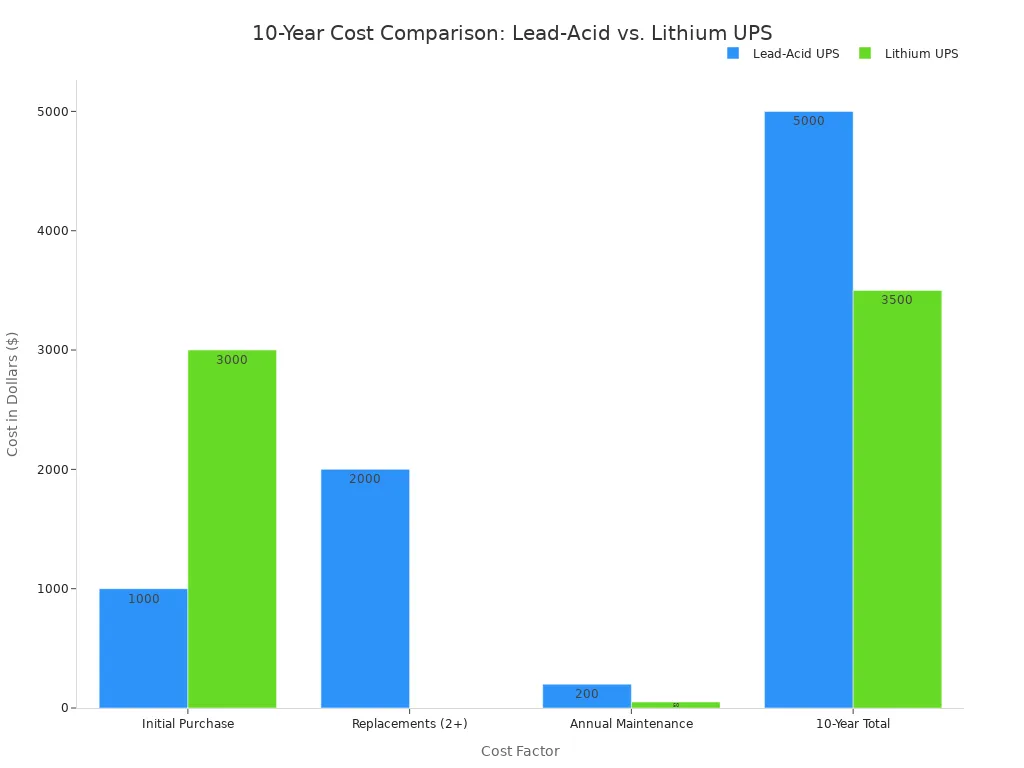
Choosing the right battery for your uninterruptible power supply begins with two key numbers: your power load (watts) and your required backup runtime. Selecting a dependable battery for your ups system is critical.
A faulty ups battery is a leading cause of unexpected system downtime, responsible for up to 65% of outages in some professional settings.
More users now rely on a lithium ion ups for a modern backup power solution. The market trend toward the lithium ion ups is strong, with lithium batteries setting a new standard for performance. A reliable lithium ion ups protects your valuable equipment.

Assess Your Power and Runtime Needs
Before you can choose a lithium ion ups, you must understand your specific needs. This starts with calculating your total power load and deciding on your ideal backup runtime. These two figures guide your entire selection process.
Calculate Your Total Power Load
First, you need to find the total power consumption of all the devices you want to protect. You can find the wattage for each device on its power label or in its user manual.
Here is a simple way to calculate your total load:
- List every device your ups system will protect.
- Find the wattage for each piece of equipment.
- Add all the wattages together to get your total power load.
- Multiply this total by 1.2. This adds a 20% buffer for future needs.
For example, a small office setup might look like this:
- Desktop PC: 120W
- VPN Router: 30W
- Network Switch: 280W
- Total Load: 120 + 30 + 280 = 430W
Tipp: If you only see amps and volts, you can estimate the wattage. Just multiply the amps by the voltage (e.g., 2 Amps x 120V = 240 Watts).
Here are some typical power ratings for common devices:
| Device | Average Power (Watts) |
|---|---|
| Desktop Computer | 100-125W |
| Laptop | 50-60W |
| Monitor | 30-50W |
Determine Your Required Runtime
Next, decide how long you need your equipment to run during a power outage. Do you need just a few minutes to save your work and shut down safely? Or do you need hours of uptime? A powerful lithium ion ups can provide extended runtime.
Sie können estimate the runtime of a lithium ion ups with a simple formula. Die runtime depends on the battery capacity and your power load. A larger battery provides a longer runtime for your lithium ion ups. The right battery ensures your lithium ion ups performs when you need it most. This calculation helps you select a battery that matches your expectations for your lithium ion ups.
Key Specs for Your UPS System

After you calculate your power and runtime needs, you must dive into the technical specifications. These details help you compare different lithium-ion batteries and find the perfect match for your uninterruptible power supply. A modern lithium ion ups relies on advanced technology to protect your devices.
Important Note: A built-in Battery Management System (BMS) is a non-negotiable feature for any lithium ion ups. The BMS acts as the battery’s brain. It protects the battery by controlling charge and discharge rates, balancing cells, and preventing over-voltage. This makes your lithium ion ups much safer than one with a traditional battery.
Match the Battery Voltage (V)
The first technical spec you must match is the voltage (V). The voltage of your new battery must be compatible with your ups system. Using the wrong voltage can damage both the battery and the UPS unit itself. You can find the required voltage in your UPS manual or on the old battery label.
For most homes and offices in North America, the standard voltage is 120V. Larger commercial applications, like data centers, might use 208V or 240V systems to support higher power capacities. Always confirm your system’s voltage before buying a new battery.
Retrofit Tip: If you are upgrading an older UPS designed for lead-acid batteries, you must check that the UPS charger’s profile is compatible with lithium-ion batteries. Some older chargers may not work correctly with a modern lithium ion ups.
Evaluate Capacity (Ah) for Runtime
Next, you need to evaluate the battery capacity, measured in Amp-hours (Ah). This number tells you how much energy the battery can store. A higher Ah rating means a longer runtime for your lithium ion ups.
You can calculate the Ah capacity you need with a few simple steps:
- Find Total Load (Watts): Use the total wattage you calculated earlier.
- Calculate Amperage (A): Divide your total load (Watts) by the battery voltage (V).
Amps = Watts / Volts. - Determine Required Ah: Multiply the amperage (A) by your desired runtime in hours.
Ah = Amps * Runtime (in hours).
For example, if your load is 270 watts and you have a 12V battery, your equipment draws 22.5 amps (270W / 12V). For 30 minutes (0.5 hours) of runtime, you would need an 11.25 Ah battery (22.5A * 0.5h).
Keep in mind that batteries with higher Ah ratings are generally larger and heavier. You need to balance your need for a long runtime with the physical space you have for your ups battery.
Check the Discharge Rate (C-Rate)
The discharge rate, or C-rate, tells you how fast a battery can deliver its energy. This is very important for a lithium ion ups, which may need to supply a large amount of power instantly when an outage occurs.
Manufacturers often rate battery capacity at a 1C rate. This means a 10Ah battery can deliver 10 amps for one hour.
- A 0.5C rate means it delivers 5 amps for two hours.
- A 2C rate means it delivers 20 amps for 30 minutes.
A high C-rating ensures your lithium ion ups can handle peak demand without voltage drops or failure. However, a very high C-rate can also generate more heat and shorten the battery’s lifespan. The actual capacity you get from your battery can be lower than its rating if your load is very high. For a typical ups system, you want a battery that can comfortably handle the sudden power draw from your equipment.
Consider the Battery Cycle Life
Cycle life tells you how many times you can charge and discharge a battery before its performance degrades. This is where lithium batteries, especially the LiFePO4 chemistry, truly shine. LiFePO4 (Lithium Iron Phosphate) is the preferred option for a lithium ion ups because of its superior safety, stability, and incredibly long cycle life.
| Batteriechemie | Typical Cycle Life |
|---|---|
| LiFePO4 (LFP) | ~5,000 cycles |
| NMC (Nickel Manganese Cobalt) | 2,000-2,500 cycles |
As you can see, LiFePO4 technology offers a much better cycle life, often lasting twice as long as other lithium chemistries. This makes your lithium ion ups a better long-term investment.
Two main factors affect cycle life:
- Entladungstiefe (DoD): This is how much of the battery’s energy you use in one cycle. Completely draining a battery (100% DoD) is much harder on it than only using 30%. More frequent, shallow discharges will extend the life of your battery.
- Temperatur: Extreme heat is the enemy of all batteries. The ideal operating temperature is between 68°F and 77°F (20°C to 25°C). For every 18°F increase above this range, a battery’s lifespan can be cut in half. Proper ventilation is critical for your lithium ion ups.
By choosing a LiFePO4 battery and managing its usage, you can expect your lithium ion ups to provide reliable power for many years.
Comparing Lithium Batteries to Lead-Acid
When you choose a battery for your ups system, you will likely compare traditional lead-acid batteries with modern lithium-ion batteries. While lead-acid has been the standard for years, a lithium ion ups offers significant advantages in lifespan, cost, size, and performance. Understanding these differences helps you make a smart investment.
Lifespan and Total Cost of Ownership
At first glance, lead-acid batteries seem cheaper. However, you must look beyond the initial price tag and consider the total cost of ownership (TCO) over the battery’s life. The much longer lifespan of lithium batteries makes them more economical in the long run.
A higher upfront cost for a lithium ion ups often pays for itself over time.
| Akku-Typ | Cost per kWh |
|---|---|
| Blei-Säure | $65-$100 |
| Lithium-Ionen | $150-$300 |
The real value becomes clear when you compare how long each battery lasts. A lead-acid battery in a UPS often needs replacement every 3-5 years. A LiFePO4 battery, on the other hand, can last a decade or more, giving it a significantly longer lifespan.
| Akku-Typ | Average Lifespan (If Cycled Daily) |
|---|---|
| Sealed Lead-Acid (SLA) | ~2 Years |
| LiFePO4 | 10+ Years |
Several factors contribute to the lower TCO of a lithium ion ups:
- Fewer Replacements: You might replace lead-acid batteries three or four times before you need to replace a single lithium battery. This saves you money on new batteries and the labor to install them.
- Zero Maintenance: Lead-acid batteries require regular check-ups, cleaning, and specific charging environments. A lithium ion ups requires no maintenance, saving you time and operational costs.
- Higher Efficiency: Lithium-ion batteries charge faster and more efficiently (96% vs. 75% for lead-acid). This means less wasted electricity and lower energy bills for your ups system.
Size, Weight, and Energy Density
Energy density measures how much power a battery can store for its size and weight. This is where lithium technology truly excels. Higher energy density means you get more power from a smaller, lighter package.
LiFePO4 batteries have an average energy density of 140 Wh/kg, while sealed lead-acid batteries only offer around 45 Wh/kg.
This massive difference in energy density has a direct impact on the battery’s physical footprint. For the same amount of power, a lithium battery is much lighter and more compact. In fact, lithium-ion batteries are often 55% lighter than their lead-acid counterparts.
| Akku-Typ | Average Weight per kWh |
|---|---|
| Blei-Säure | 30 Kg (66 lbs) |
| Lithium-Ionen | 6 Kg (13 lbs) |
This makes a lithium ion ups easier to install, move, and fit into tight spaces. The superior energy density provides more flexibility for home and office setups where space is often limited. You get powerful backup without the bulk.
Performance and Maintenance Needs
Performance during a power outage is critical. A lithium ion ups provides more reliable and stable power compared to lead-acid. This is due to how each battery behaves under a heavy load.
Lead-acid batteries suffer from “voltage sag.” When your equipment suddenly draws a lot of power, the voltage from a lead-acid battery drops significantly. This can cause your inverter to shut down, even if the battery is not empty. Lithium batteries maintain a stable voltage throughout their discharge cycle.
| Akku-Typ | Voltage Behavior Under Heavy Load |
|---|---|
| Blei-Säure | Experiences significant voltage sag |
| Lithium-Ionen | Maintains a stable voltage output |
This stable power delivery ensures your sensitive electronics run smoothly without interruption.
Perhaps the biggest daily difference is maintenance. Lead-acid batteries demand constant attention to function safely and effectively.
Typical Lead-Acid Maintenance Schedule:
- Weekly: Check for alarms, cracks, or leaks.
- Monthly: Inspect terminals for corrosion and clean them with a wire brush.
- Quarterly: Test voltage levels and check internal connections.
- Sicherheit: Always wear gloves and goggles. Use special tools to avoid short circuits and have a plan for acid spills.
In contrast, lithium batteries are a “set it and forget it” solution. Thanks to the internal Battery Management System (BMS), they require zero routine maintenance. This eliminates the labor, cost, and safety risks associated with lead-acid battery care.
Finalize Your Selection Criteria
You have the technical specs. Now you can focus on the final details that ensure your new battery fits your space and works safely with your equipment. This involves choosing a form factor, confirming compatibility, and considering the warranty.
Home vs. Office Form Factors
You need to pick a battery that physically fits your environment. For most home desktop setups, the common choice is a tower unit. These freestanding units look like small PC towers. For professional IT closets, a rack-mounted lithium ion ups is standard.
This table compares the two main styles:
| Merkmal | Rack-Mounted UPS | Tower UPS |
|---|---|---|
| Am besten für | IT closets with server racks | Home offices or standalone setups |
| Einrichtung | Mounts into a standard 19-inch rack | Stands on the floor or a shelf |
| Space Use | Saves floor space | Occupies floor or desk space |
Both form factors deliver the same performance. Your choice depends entirely on where you will place your ups system.
UPS Model Compatibility
You must choose a battery that is certified for your specific uninterruptible power supply model. Using an unapproved third-party battery is risky. It can fail early and may even void your equipment’s safety certifications. The specialized chemistry of a lithium ion ups requires a perfect match between the battery and the charger’s safety features.
Tipp: You can find official compatibility lists on manufacturer websites. Brands like Eaton and CyberPower offer a “UPS Battery Finder” tool. You simply select your ups system brand and model to see approved options.
Warranty and Brand Reputation
A good warranty reflects the manufacturer’s confidence in its product. A quality lithium ion ups often comes with a longer warranty than its lead-acid counterpart.
| Akku-Typ | Typical Manufacturer Warranty |
|---|---|
| Lithium-Ionen | 5 years |
| Sealed Lead-Acid | 3 years |
The longer warranty on a lithium ups battery protects your investment. Choosing a reputable brand ensures you get a reliable battery that performs as promised. When it comes to power protection, you truly get what you pay for.
Choosing the right battery is simple. You calculate your load, match the voltage and capacity, and pick a form factor. A lithium ion ups has a higher initial cost. However, its longer lifespan and zero maintenance deliver a lower total cost of ownership. Over a decade, lithium-ion batteries can provide TCO savings of 50% or more.

Investing in modern lithium batteries for your lithium ion ups protects your equipment with a reliable, long-term solution.
FAQ
Can I use a lithium battery in my old lead-acid UPS?
You should check compatibility first. An older UPS may not charge a lithium battery correctly. This can damage the battery or the UPS unit. Always check the manufacturer’s guidelines to ensure safety and proper function.
How do I dispose of an old UPS battery?
You cannot throw old batteries in the trash. 🚮 They contain materials that can harm the environment. You should take old lead-acid or lithium batteries to a certified e-waste recycling center or a local hazardous waste facility.
Is a more expensive lithium battery always better?
A higher price does not always mean better performance for your needs. You should focus on the technical specs. Choose a battery with the correct voltage, capacity (Ah), and a good warranty from a reputable brand that fits your budget.
How long does a lithium UPS battery take to charge?
Charge time depends on the battery size and your UPS charger. Lithium batteries charge much faster than lead-acid models. You can typically expect a full charge in 2-4 hours, getting your backup power ready again quickly.

